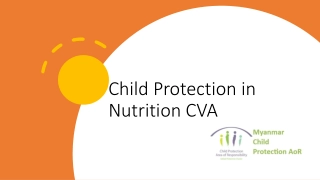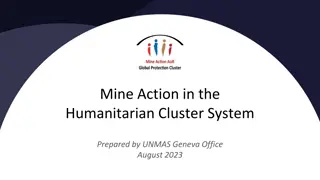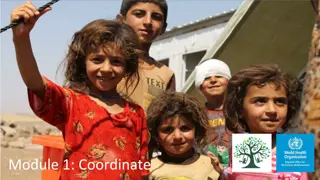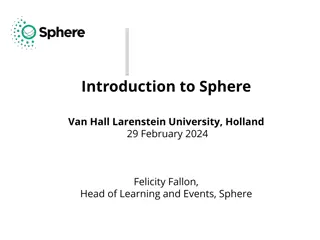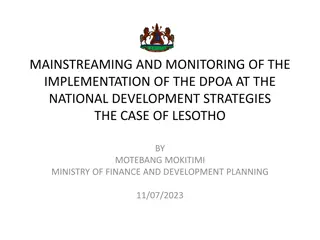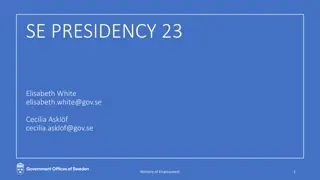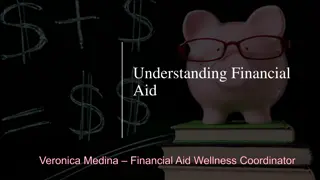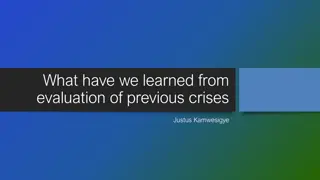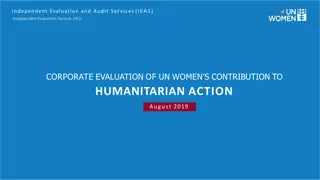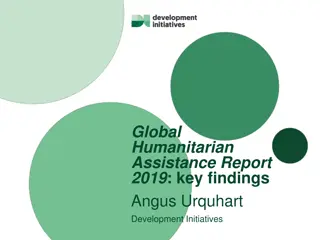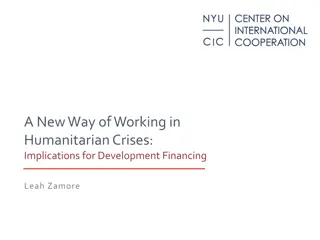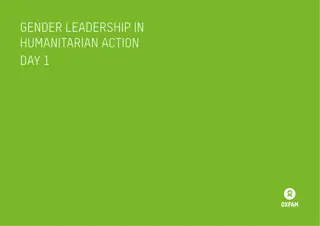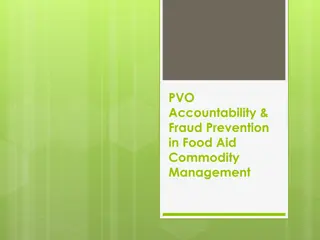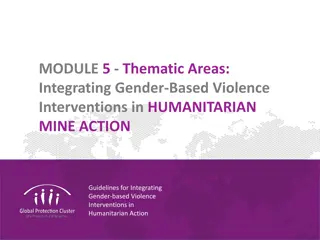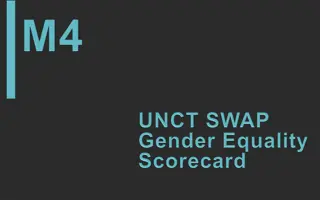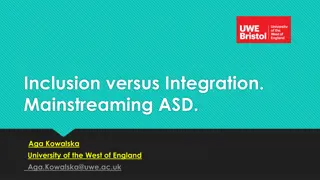Understanding Protection Mainstreaming in Humanitarian Aid
Protection Mainstreaming in humanitarian aid involves incorporating protection principles to ensure meaningful access, safety, and dignity for affected populations. Key elements include prioritizing safety and dignity, ensuring meaningful access without barriers, and establishing accountability mechanisms. The process focuses on how aid is delivered rather than solely on the products or services provided. Feedback, transparency, and participation are essential aspects of ensuring effective protection mainstreaming in programming.
Download Presentation

Please find below an Image/Link to download the presentation.
The content on the website is provided AS IS for your information and personal use only. It may not be sold, licensed, or shared on other websites without obtaining consent from the author. Download presentation by click this link. If you encounter any issues during the download, it is possible that the publisher has removed the file from their server.
E N D
Presentation Transcript
Protection Mainstreaming ICCG IHF 1stStandard Allocation Erbil, Iraq 26 February, 2018
Protection Mainstreaming What is Protection Mainstreaming ? The process of incorporating protection principles and promoting meaningful access, safety and dignity in humanitarian aid. Although not all agencies programming, every agency has a responsibility to include protection principles into programmes. Protection Mainstreaming focuses not on WHAT we do (the product/service) but rather on HOW we do it (the process) implement protection
4 Key Elements > 1. Prioritize safety and dignity and avoid causing harm: Identifying the physical and psychological threats affected populations can face in accessing our services, and act to prevent, minimize or mitigate the negative effects of our intervention. > Examples: Provide assistance in safe and secure locations (away from threats such as violence, GBV, attacks). Ensure access to services norms/practice. Ensure the design of facilities preserve the safety and dignity of individuals. Do not share identifiable information unless informed consent has been given. Ensure confidentiality and privacy in any form of consultation. Consider potential tensions between affected population and host communities. respects culture and religious
4 Key Elements > 2. Meaningful access: Ensure access to assistance in proportion to need and without barriers (e.g. physical, information). Pay attention to those who are particularly vulnerable or have difficulty accessing services. financial, discrimination, > Examples: Consult with all population groups (AGD approach) to identify specific needs and challenges they may face. Develop vulnerability criteria. Make adaptation to infrastructures accessed by persons with reduced mobility. Monitor access to services, potential discrimination and services being diverted. to ensure services can be
4 Key Elements > 3. Accountability: Set up appropriate mechanisms through which affected populations can measure the adequacy of interventions and address concerns or complaints. > Examples: Be assistance). Monitor how assistance is delivered is it reaching the identified population? Is it meeting the needs identified? complaints mechanism. transparent (provide information about how to access Set-up comprehensive
AAP includes: Feedback and complaints: Actively seek the views of affected communities to improve policy and practice in programming Trans- parency: Provide timely and adequate information Partici- pation: Enable affected communities to play an active role in the decision- making processes (commitments endorsed by the Interagency Standing Committee, 2011)
Accountability to affected populations Beneficiaries are key partners in their own future. Three key areas: 1. Information provision (CwC): Provide to affected people accurate, timely and accessible information about assistance. Information provided has to be clearly understandable by everyone, irrespective of their age, gender, or other characteristics. 2. Consultation (CwC): Seek the views of all segments of the affected population and invite feedback throughout each stage of the project cycle. 3. Complaints and feedback mechanisms (CFMs): Provide a means for affected people to voice complaints and provide feedback on areas relevant to operations in a safe and dignified manner. A CFM system must include established procedures for recording, referring, taking action and providing feedback to the complainant. Valid complaints and useful feedback must be taken into account to ensure improved programming.
4 Key Elements > 4. Participation and Empowerment: Support the development of capacities. Assist people to claim their rights, including (not limited to) the rights to shelter, food, water, sanitation, health, education. > Examples: Consult regularly with all layers of the society and include the affected population in project design and evaluation. Work with local authorities and civil society. Identify the coping mechanisms and design intervention to avoid resorting to negative coping mechanisms. Hand-over facility management to community or local authorities. Support representative community groups.
Tools - Collective Level > Protection Risk Analysis Methodology and Report Template: Template to gather information about threats, vulnerable groups and capacities. > Protection Mainstreaming Action Plan: Template for planning and reporting on protection mainstreaming related activities. > Protection Mainstreaming in Funding Allocation Process Score Card: Template to assess the quality of proposal submitted to the review board. > Protection Mainstreaming Process and Impact Indicators: List of suggested indicators to monitor protection mainstreaming. > Protection Mainstreaming in Field Clusters Process Score Card: Template to evaluate the mainstreaming of protection in the cluster level system.
Tools Individual Level > Beneficiary beneficiary s accountability and participation. > Project Design Assessment: Template to assess the project proposal alignment with PM principles. > Staff Assessment : Template to assess the staff knowledge and skillset on PM. > Protection Mainstreaming Action Plan: Template for planning and reporting on PM activities. > Protection Mainstreaming Process Score Card: Template to assess the level to which the organization has followed the steps to effectively mainstream protection. > Protection Mainstreaming Impact Score Card: Template to assess the impact of having mainstreamed protection on affected populations. Assessment perception (Baseline/Endline): of safety/dignity, Template access to gather services, to
Global Resources and Support >Material Available: Protection Mainstreaming Training Package Protection Mainstreaming Sector-Specific Checklists (Guidance App) Protection Mainstreaming Videos Tip Sheets / Guidance Notes - Protection Cluster, Cluster, ICCG, HCT >Coming soon: Protection Mainstreaming E-Learning Course Protection Mainstreaming Toolkit
Global Resources and Support GPC Protection Mainstreaming Training Package: Available in English, French, Arabic and Spanish
Global Resources and Support GPC Protection Mainstreaming Sector-Specific Checklists and Guidance App
Global Resources and Support >GPC Protection Mainstreaming Video is a short on the four principles of protection mainstreaming >The video is available in English with Spanish and Arabic subtitles. >http://www.globalprotectioncluster.org/en/ar eas-of-responsibility/protection- mainstreaming.html
Gender Marker in IHF Proposals ICCG 26 February 2018
What is Gender? Gender is a socially constructed definition of women and men. It is not the same as sex (biological characteristics of women and men) and it is not the same as women. Gender is determined by the conception of tasks, functions, roles and responsibilities attributed to women and men in society and in public and private life.
Why should gender be considered in proposals? Different Roles Different Needs Better Response
Gender Marker in IHF Proposals To Achieve a 2a code, gender concerns must be addressed in: Needs Analysis Activities Outcomes
Gender marker in IHF proposals Needs Analysis > - Who is affected? How are they affected? Who has access and what are the barriers to accessing services? Do women and men participate equally in decision making? Activities/Outcomes > - All activities should relate to and be justified by the needs and context described. > - Need to provide target proportions (men, women, boys and girls) to enable monitoring of equitable participation and fair distribution of resources. > - Set targets, and explain why you set them, for the participation levels of women, girls, boys and men in the various activities. Ratios do NOT have to be 50-50 --- they rarely are.
Criteria that Should be Addressed in Proposal Development > Design services that meet the needs of the target population Show how women, girls, boys and men use the services or benefit from them > Example: Separate latrines for men and women in service delivery areas > Access to service for women, girls, boys and men Examine barriers that might exist to access for certain groups > Example: Examine the composition of women and men in service delivery teams. Examine if registration for services is not excluding some highly vulnerable groups such as female headed households, widows, etc. > Participation of women and men Ensure women, men, boys and girls participate in design, implementation, monitoring and evaluation. > Example: How many women are in decision making positions for the project design and implementation?
Criteria that Should be Addressed in Proposal Development > Training should benefit men and women equally Example: In cash for work activities, avoid male only work. Tailor trainings to accommodate women. (ex. can women bring their children or is child care provided?) > Address Gender-Based Violence Services delivered should not put individuals at risk of GBV > Example: Examine the presence of lighting and lamps around service delivery areas (in camps, settlements, etc.) with a specific emphasis paid to sanitation facilities. Examine distance between toilets, water points and dwelling places to reduce risk of GBV. Examine the timing of distribution of food and non food items for safety and security. > Collect, Analyze, and Report on Sex/Age Disaggregated Data (SADD) Assists with determining needs and gaps among different groups that have not been met Collect SADD using quantitative methods such as surveys, registration lists, distribution lists, clinic records etc. Qualitative methods such as key informant interviews, focus group discussions and one-on-one in-depth interviews should be used also.
Gender disaggregated indicators > Indicators should be disaggregated by sex and age to show the proportions of male and female who will benefit. > # of farmers benefitting from agricultural inputs and livestock. > # of men and women farmers benefitting from agricultural inputs and livestock. > # of children attending school > # of girls and boys attending school > # of health workers receiving training > # of men and women health workers receiving training > Gender Marker Tip Sheets by sector: https://www.humanitarianresponse.info/topics/gender/document/gender- marker-tip-sheets-english
Protection from Sexual Exploitation and Abuse (PSEA) in IHF Proposals ICCG 26 February 2018
Protection from Sexual Exploitation and Abuse (PSEA) Sexual exploitation = any actual or attempted abuse of a position of power, vulnerability or trust for sexual purposes 1) Often an exchange 2) Always an improper use of position 3) With purpose to benefit from it ex. Paying for sex; engaging in a sexual relationship in exchange for a job or for more rations/goods/shelter, etc. Sexual abuse = the actual or threatened physical intrusion of a sexual nature by force or under unequal /coercive conditions ex. Sex with a minor (under 18), rape, inappropriate touching, etc.
The PSEA Code of Conduct The Secretary General Bulletin (ST/SGB/2003/13) outlines the UN s zero tolerance approach to SEA. It prohibits the exchange of money, employment, goods or services for sexual favours or other forms of humiliating, degrading or exploitative behaviour It is the UN s Code of Conduct on PSEA. It applies to: All UN staff and humanitarian/aid workers All persons that have entered into a cooperative arrangement (or contract) with the UN (employment/partnership) Example: drivers, cleaners, daily laborers, distribution staff, etc. Standards apply at all times even when on leave or off duty.
Grant Agreement- Article IV clause 4 and 5 The Implementing Partner acknowledges and agrees that United Nations and OCHA have zero tolerance for abuse and misconduct, including sexual exploitation and abuse. It shall communicate accordingly to its Personnel and shall take all reasonable measures to prevent abuse and misconduct. In particular, but not limited, the Implementing Partner represents and certifies to undertake all reasonable actions to prevent: sexual exploitation and abuse, sexual and work place harassment, discrimination, assault, threat, jeopardizing life of staff or others, abuse of authority, mismanagement, misuse and misappropriation of assets and funds, theft, fraud, corruption, misrepresentation, collusion and other violation of procurement principles, gross negligence, conflict of interest, violation of the relevant law, and/or of International Humanitarian, Human Rights and Refugee Law and of humanitarian principles, abuse of UN status, privileges and immunities, violation of confidentiality, violation of terms and contractual clauses under this Agreement. The Implementing Partner must comply with all requirements of the UN Standards of Conduct
Six Core Principles 1. Sexual exploitation and abuse is serious misconduct and ground for disciplinary measures, including summary dismissal. 2.Sexual activity with children (persons under the age of 18) is prohibited - regardless of the age of majority or age of consent locally. Mistaken belief in the age of the child is not a defence. 3. Exchange of money, employment, goods or services for sex, including any humiliating, degrading, or exploitive behaviour is prohibited. This includes beneficiaries but also job seekers.
Six Core Principles 4. Sexual relationships between staff and beneficiaries of assistance (since they are based on unequal power dynamics) are strongly discouraged. 5. Where a staff member has concerns or suspicions regarding sexual exploitation or abuse by a fellow worker, whether in the same agency or not, he/she must report such concerns via established reporting mechanisms. In Iraq, this includes the PSEA Network (emond@unfpa.org) or the UN IDP Call Centre (80069999) 6. Staff and related personnel are obliged to create and maintain an environment that prevents sexual exploitation and abuse. Managers at all levels have an additional responsibility to do so.
PSEA in your Projects > Project proposal: Have you analyzed risk of SEA? Will your staff have one-on-one interactions with the beneficiaries? Will your project include distribution of goods such as food, water, NFI, shelter, or cash? Will your staff control or influence access to services such as livelihood opportunities, health care, education, etc.? Does your proposal include activities/strategy (and budget) to reduce SEA risks? Awareness raising materials or sessions Training for beneficiaries and/or for staff on PSEA. PSEA policy in place, including Code of Conduct
PSEA in your Projects >Monitoring and Evaluation: identify, collect, and analyze key indicators. % of staff with signed Code of Conduct % of staff who received briefings or trainings on PSEA % of activities where Code of Conduct and/or PSEA communication materials are displayed. # of post-distribution or post-activity assessments, surveys, or feedback forms completed. These should include questions such as: o Did you feel safe? o Were you ever asked to pay or give anything in exchange for your assistance? o Do you know how to report abuse or exploitation? Future activities should be modified based on this feedback!
PSEA in your Projects >Staff Training: Assess the need for staff training on PSEA, and plan/budget for trainings as required. >Outreach and awareness raising: Key Messages should include: This humanitarian assistance is free. You should not be asked to give money or anything else in return for your assistance. If you feel unsafe or wish to file a confidential complaint, please call the free UN IDP Information Centre Hot Line (80069999).
PSEA Resources > Iraq PSEA Network: Jennifer Emond, emond@unfpa.org; 07510157328; - Douglas Jennings, douglas.jennings@wfp.org, 07827806774 > Global PSEA Task Force Tools: http://pseataskforce.org/ > PSEA Implementation Quick Reference Handbook: http://www.chsalliance.org/files/files/PSEA%Handbook.pdf > Frequently Asked Questions: http://www.pseataskforce.org/uploads/tools/faqsseabyunperson nelandpartners_echaecpsunandngotaskforceonpsea_english.pdf


